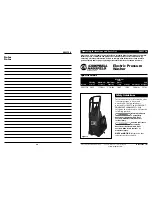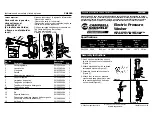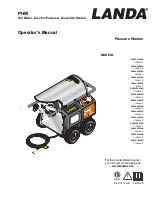
19
Changing Engine Oil
If you are using your pressure washer under extremely dirty
or dusty conditions, or in extremely hot weather, change the
oil more often.
KEEP OUT OF REACH OF CHILDREN. DON’T
POLLUTE. CONSERVE RESOURCES. RETURN
USED OIL TO COLLECTION CENTERS.
Change oil while engine is still warm from running, as
follows:
1. Drain fuel tank by running pressure washer until fuel
tank is empty.
2. Disconnect spark plug wire and keep it away from
spark plug.
3. Clean area around oil fill, remove oil fill cap / dipstick.
Wipe dipstick clean.
4. Tip your pressure washer to drain oil from oil fill into a
suitable container making sure you tip your unit away
from spark plug. When crankcase is empty, return
pressure washer to upright position.
5. Slowly pour recommended oil (about 0.6 lt (20 oz.))
into oil fill opening. Pause to permit oil to settle. Fill to
FULL mark (top hole) on dipstick.
6. Wipe dipstick clean each time oil level is checked. DO
NOT overfill.
7. Replace and tighten dipstick.
8. Wipe up any remaining oil.
9. Reconnect spark plug wire to spark plug.
Service Air Cleaner
Your engine will not run properly and may be damaged if
you run it with a dirty air cleaner. Service more often if
operating under dirty or dusty conditions.
To service the air cleaner, follow these steps:
1. Slide air cleaner lever (
A
) to unlock (
) position and
tilt cover (
B
) down.
2. Carefully remove air cleaner to prevent debris from
falling into carburetor.
3. Wash foam air cleaner (
C
) in liquid detergent and
water. Squeeze dry in a clean cloth.
4. SATURATE foam air cleaner in engine oil and squeeze
in a clean cloth to remove excess oil.
5. Reinstall clean or new foam air cleaner in base (
D
).
6. Tilt cover up and slide lever to lock (
) position.
Service Spark Plug
Changing the spark plug will help your engine to start easier
and run better.
1. Clean area around spark plug.
2. Remove and inspect spark plug.
3. Replace spark plug if electrodes are pitted, burned or
porcelain is cracked. Use the recommended
replacement plug. See Specifications.
4. Check electrode gap with wire feeler gauge and reset
spark plug gap to recommended gap if necessary (see
Specifications
).
5. Install spark plug and tighten firmly.
Inspect Muffler and Spark Arrester
Inspect the muffler for cracks, corrosion, or other damage.
Remove the spark arrester, if equipped, and inspect for
damage or carbon blockage. If replacement parts are
required, make sure to use only original equipment
replacement parts.
CAUTION
Avoid prolonged or repeated skin contact
with used motor oil.
• Used motor oil has been shown to cause skin cancer in certain
laboratory animals.
• Thoroughly wash exposed areas with soap and water.
WARNING
Exhaust heat/gases could ignite
combustibles, structures or damage fuel
tank causing a fire, resulting in death,
serious injury and/or property damage.
Contact with muffler area could cause burns resulting in
serious injury.
• DO NOT touch hot parts and AVOID hot exhaust gases.
• Allow equipment to cool before touching.
• Keep at least 1.5 m (5 ft) of clearance on all sides of pressure
washer including overhead.
• Contact the original equipment manufacturer, retailer, or dealer
to obtain a spark arrester designed for the exhaust system
installed on this engine.
• Replacement parts must be the same and installed in the same
position as the original parts.
D
C
B
A
Not
for
Reproduction






































